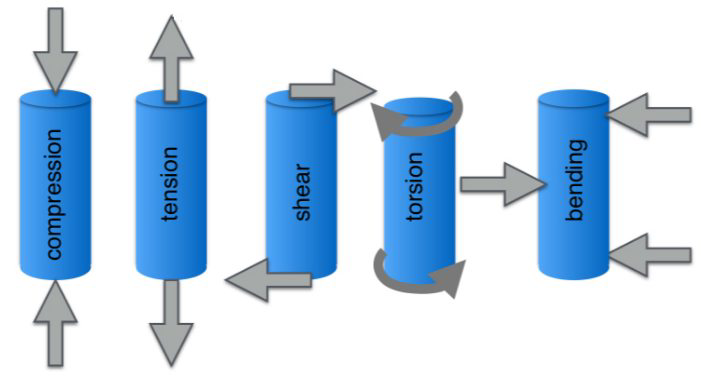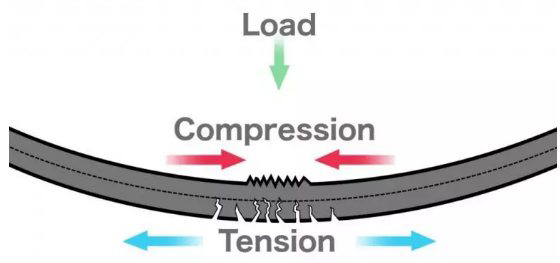五种力的作用效果
力(force)和应力(stress)的区别
注:剪和切是一致的,切应力就是剪应力,而剪力就是传统力的概念。
There are five fundamental types of loading: compression压缩, tension拉伸, shear剪切, torsion扭转, and bending弯曲. 参考

compression和tension的例子
shear的例子
根据字面意思,想象一下剪刀的工作原理,就是利用剪切力将物体分开。上图中的剪切力的作用面积就是筷子的截面积。
应力-应变曲线(Stress–strain curve)
若没有特别标明,应力-应变曲线是指在拉伸测试下正向应力及正向应变之间的关系。应力和应变分别为$$\sigma=\frac{F}{A_{0}} \quad \epsilon=\frac{L-L_{0}}{L_{0}}=\frac{\Delta L}{L_{0}}$$应力的单位和压强的单位一致,应变则是一个无量纲的量。在拉伸试验下,记录不同应变下,材料应力的变化,一直到材料断裂为止,描绘其曲线,即为应力-应变曲线。一般会假设材料在整个拉伸过程中,其截面积不会变化,不过在变形过程中,截面积也会略为变小。
 上图是室温下低碳钢的应力-应变曲线,大体上可以分为三个阶段:
上图是室温下低碳钢的应力-应变曲线,大体上可以分为三个阶段:
(1) 线性弹性阶段,遵循胡克定律,斜率为杨氏模量。此阶段的结束恰好是塑性变形的开始,该点的应力即为屈服强度(屈服应力)。
(2) 应变硬化阶段,对应的应力范围大小,大于屈服强度,小于极限强度。极限强度就是曲线的最高点对应的应力大小。这个区域一开始的应力不随应变变化,有短暂的水平之后,继续呈现应力增大应变增大的趋势。
(3) 颈缩阶段,也就是应力超过极限强度后,材料的某一段的截面积明显比平均截面积小。应力在截面积较小的区域很容易集中,因此颈缩会自我增强,让应力更集中,正反馈使得材料很快断裂。
Moment of Inertia and Polar Moment of Inertia are both the quantities expressing a body’s tendency to resist changes when certain torque is being applied.
Moment of Inertia is often refereed as mass moment of inertia or the angular mass. It is the measure of an object’s resistance against the angular acceleration. The resistance being done here is against the rotation rate when certain torque is applied.
On the other hand, Polar Moment of Inertia is a measure of a body’s ability to resistance against the torsion when torque is being applied. It is utilized to calculate the angular displacement of a body subjected to torque.来自
转动惯量和 极惯性矩(截面二次极矩)$$\begin{array}{l} \rho^{2}=y^{2}+z^{2} \\ I_{P}=I_{y}+I_{z} \end{array}$$